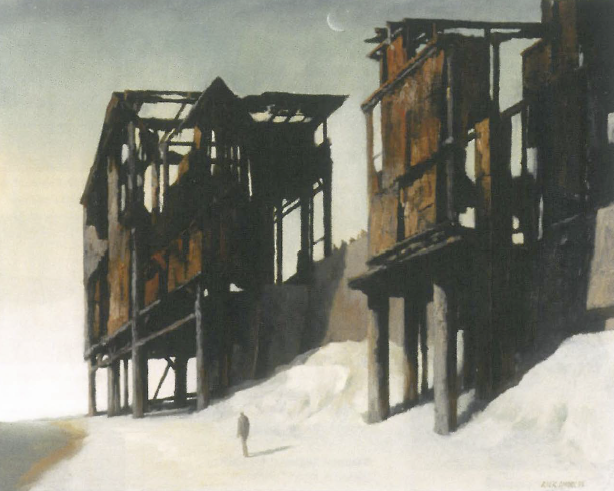
One of the most puzzling episodes on Melbourne's art scene during the mid 1990s arose when the Australian Centre for Contemporary Art put out a promotional brochure which listed every artist to whom it had given a solo exhibition – except one. The name of Rick Amor was inexplicably missing from the official rollcall. Tongues were wagging for weeks, with much speculation as to whether the omission was deliberate, and, if so, what the reason was for his erasure from the records. Was it political, an art scene version of those doctored Soviet photographs in which figures disliked by the authorities were blotted out of historic snapshots? Some were unsure, others strongly insisted it was. If so, then what sin had Amor committed that warranted such treatment?
Amor was – and a decade later continues to be – an artist whose work arises entirely from his personal interests. He obsessively paints moody scenes which are part childhood memory, part fantasy about our future. Crumbling and decayed, everyday Australian cities and suburbs are depicted as if they have entered their twilight years. All looks rundown, with streets dark and deserted, buildings dusty and uncared-for, the sky heavy with storm clouds or discoloured by smog, and vegetation either dead or running wild.
The disintegrating city is a theme much explored in commercial film; although rather than having an affinity with The Omega Man, Blade Runner or Escape from New York, Amor's distinctly unglamorised view of the everyday gone to rack-and-ruin seems closer in temper and formal resolution to the 18th century printmaker Giambattista Piranesi. Not his much admired Carceri, the celebrated torture halls and fantastic penitentiaries, but his more numerous views of mouldering classical edifices along the streets of Rome whose steady sales kept the Baroque artist's purse full. Amor even borrows from Piranesi those dishevelled sauntering street figures which make each scene look desolate, and also manages to exaggerate the scale of buildings. Everything is a little too big and shadowy and overpowering for the viewer's comfort.
What are we to make of such dystopian visions? Amor's mind very clearly runs counter to that still prevailing spirit of technological and social progress, the promise that we are working towards constructing a better world. The artist apparently doesn't believe the confident rhetoric of a Howard or Costello: it's there in the very paintings, an unremittingly bleak image of modern Australia, indeed, a recurring motif is the street corner where the first settlers stepped ashore and founded Melbourne (he always depicts it in a decaying state).
And yet the strong political overtones, the lack of faith in the edifice of late capitalism, seems a side issue. Because, like Piranesi, Amor isn't preaching. He isn't horrified by the declining rat and roach infested corners of a city: he positively relishes them. They fire his imagination. In previous shows he has lovingly assembled his disintegrating world from visual fragments of Melbourne, Barcelona, New York and, of course, the Victorian coastal town of Frankston where he grew up. This time around the main reference points are supplied by Sydney, a city whose waterfront and law court districts he has made look thoroughly ruinous and decrepit.
The imagery is emotive enough with its wrecked ships and ravaged buildings, although much is conveyed in the execution. Using a palette suggestive of rust, broken brick and flaking concrete, Amor has set his oil paint down in an economical, loosely brushed manner, often over a red gesso which gives his shadows an unsettling dull glow. Particularly tasty in the latest show was Journey III, a painting of condemned warehouses near the harbour which are made to look not so much aged and worn out as – if we err into pathetic fallacy – senile. They are literally broken shells, reduced to a state of meaninglessness, all sense of their function and reason for being having been obliterated.
A decade back, the consensus view around Melbourne's artists was that Rick Amor had fallen out of favour in art museums because, being a figurative painter, his work was deemed too conservative and backward looking. It wasn't perceived as 'hip' or 'cutting edge', in other words, it didn't fit in with current curatorial agendas. Nowadays one has to ask exactly who is being conservative. In his choice of medium and artistic style, Amor does have his roots firmly planted in the tradition of Western painting. There is no doubting that. Nevertheless, the content of his work is jarringly contemporary and of our moment, with the artist presenting a plain, if unpalatable view of Australia's cities that raises questions about what it is that Western culture has achieved in this part of the globe. Does nobody see, or do they see all too well?












